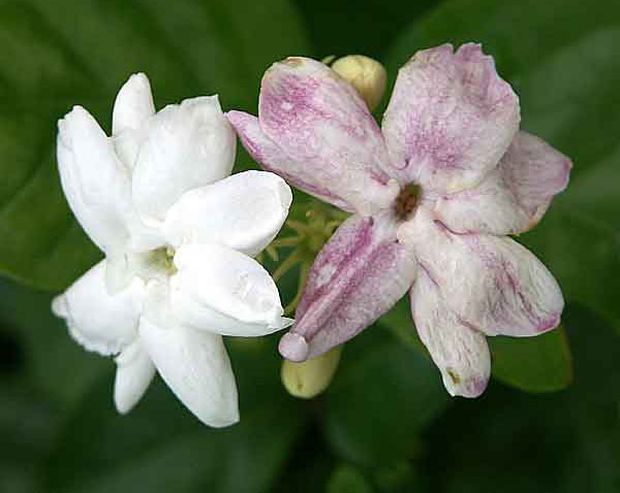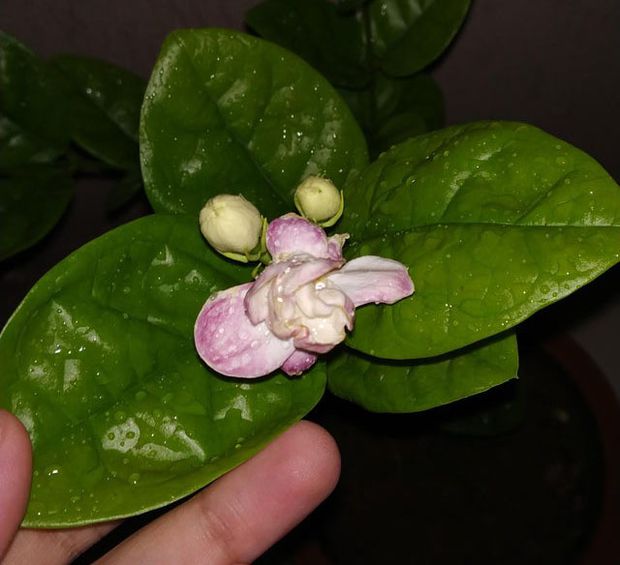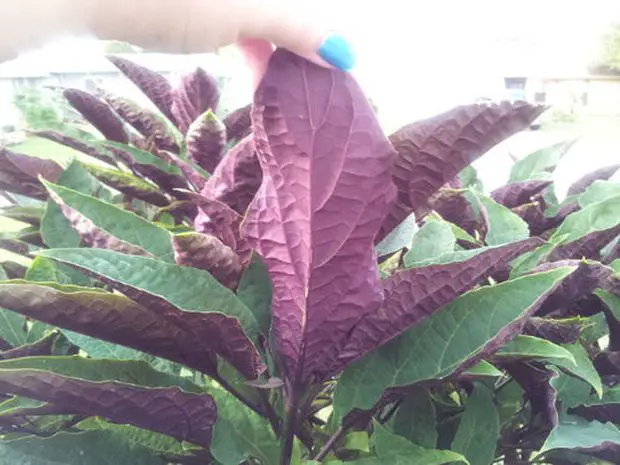Arabian jasmine is most famous for its sweet and strong fragrance. It is a fast-growing climbing vine and shrub. Both its leaves are dark vibrant green and its flowers are creamy and waxy, compiling an exquisite plant for enjoyment, both indoors and outdoors. As we have learnt, growing these gorgeous plants, can be challenging at times, even-though you take special care, sometimes issues can still arise, such as, its flower turning purple. There are a few causes why our Sambac leaves are turning purple and we will dive into them and how to fix them in this post.

The reasons why your Arabian Jasmine is turning purple, are all related to stressful processes happening in the plant. Some are environmental, such as, too much light exposure, excess of watering, underwatering and temperature shock. Some, alternatively or in addition, that purple colour in our Arabian jasmine plant can be more restricted to the inner processes of the plant, such as, phosphorus deficiency, insect infestation (Contarinia maculipennis larvae) and root rotting, comprising Phytophthora Root Rot fungal infection)
What Causes my Arabian jasmine plant to turn purple?
Too much heat or light
We are well aware that our Arabian jasmine plant is a sun lover and it needs about five to six hours of semi direct light everyday to thrive and produce those exquisite flowers. However, too much light and hence too much heat, can be pretty detrimental and can burn our plant. One of the main signs of scorching (heat stress) in Arabian jasmine plant is discolouration and colour pattern change, such as, the leaves turning purple. If your Arabian jasmine plant is located in a spot where it is receiving too much direct sun light, its cells will start getting damaged and the plant won’t be able to function properly anymore. When our plant gets too much sunlight, the leaves get bleached, so to speak. Jasmine plant undergoes a process called photo-protection, when this happens, in a response to stress process to shield themselves. However, when there is an excess of heat and energy, the sunlight provokes a cellular damage affecting the photosynthetic process, where chlorophyll (responsible for the green colour) can’t keep up being broken down. That excess of heat is released by activating other pigments in the plant, such as, carotenoids and anthocyanins (responsible for red, orange tones). This is the reason why the leaves of our jasmine plant becomes more dark red to purple tones. We need to ensure to give our jasmine plant enough hours of light for it to grow optimally but the perfect shade and rest period to resent their leave and flower production.
Nutrient deficiency
Phosphorus is an essential macronutrient, involved in major processes of the plant, such as, photosynthesis, biosynthesis of sugars, energy transfer and nutrient movement within the plant. It is a key player in the processes of the rooting, flowering, and fruiting of the plant. When this macronutrient is limiting in our Arabian jasmine, a series of stress responses occur, such as, decrease in the number of leaves and stems in the plant and most striking, a change in colour in the leaves. This change in colour is when due to phosphorus deficiency, the green leaves start turning to a purple and violet colour. This is because there is a built up of carbohydrates in the leafy tissue, when the photosynthesis machinery is really saturated, breaking up more carbohydrates for leave growth and glucose production. This leads to the older leaves (which are of a a dull and dark green colour) to start displaying a purple tone, beginning at the tips and undersides of the jasmine leaves and eventually it will affect the rest of the plant. In addition, a phosphorus deficiency very commonly leads to issues with the pH balance and deficiencies of other nutrients, such as, nitrogen or potassium and calcium. This will lead to the leaves becoming thicker, with a stiff and dry feel. If all these deficiencies are left untreated, the integrity of the plant will be compromised and eventually die off. The way we help fixing this issue is to feed our Sambac jasmine, properly and frequently (as we have covered in previous posts). Usually, following a regime of once every three months or so with a high in nitrogen and phosphorus, slow release fertiliser to prevent our jasmine plant from suffering one of these macronutrients deficiency.
Contarinia maculipennis insect infection
Aarabian or sambac jasmine produces strongly scented exquisite flowers all throughout the year, usually growing in clamps or clusters of about 12 to 20 per small vine. Sometimes, we may do everything in our hands to meticulously care for our plant and still somethings are out of our control and will deter our jasmine plant. A pretty good example is Contarinia maculipennis infection in our jasmine plant. Contarinia maculipennis, also known as, blossom midge, constitute one of the largest families of Diptera, insects that will feed on the buds of our sambac jasmine and thus affecting its development and colour shifting it to a purple colour. That leads to those buds to dry up and eventually fall off. The reason why those buds turn to purple is due to the toxic saliva of the larvae (sometimes even groups of five larvae in one single bud) of these insects when feeding from the inner bud and petals or our Arabian jasmine plant. Usually, after reaching their maturity, they fall off in the soil to further develop into the fly stage in the form of pupae buried in the soil bedding of our plant. Like this, the cycle will repeat when those adult flies will move inside the bud to lay the larvae and thus deterring our jasmine flowers and changing their petals colour to purple. The way we can help with this issue is by making use of insecticides, such as, Monocrotophos or Profenophos to be sprayed around the plant and specially around the flower buds. Also, tilling the soil often to expose those pupae to sun and hence killing them.

Overwatering
Another very common cause for our Arabian jasmine leaves to turn purple is overwatering. We know that jasmine does not like too much water in the soil, in fact, it rather prefers a well drained soil and it doesn't thrive on excess of moisture in the roots. Precisely, this excess of moisture will cause the rooting system to start wilting, which prevents the plant from being able to absorb water and nutrients and hence turning the leaves to a purple tone.

Abrupt temperature fluctuations
This commonly takes place when a sudden cold snap or sudden warming occurs. Arabian jasmine plant is particularly sensitive to this stressful environmental processes. As a result, the photosynthesis process will get delayed and the plant will also stop its growth and as a consequence there will be a change in colour in the leaves mainly.
Underwater
Equally problematic to overwatering, is underwatering. Arabian Jasmine plant cannot thrive, if it is not receiving enough water, in fact, jasmine is pretty sensitive to a shortage of water leading to a decrease in the pressure of the leaves and causing wilt to build up in those tissues. As a consequence, the surface of the leaves will lose their silky and smooth texture shifting it to a wrinkly and crispy appearance. The UV protection mechanism of the plant, which main component is anthocyanin, will get activated and excited, as a response to that temperature stress because of the lack of water and thus switching the colours of the leaves to purple tone. So we need to ensure we water our Arabian jasmine plant often enough, by checking the moisture in the soil, introducing a finger in the soil to ensure the bedding is not completely dry out but definitely ensuring that the excess of water has drained out.
Root rot
Sometimes our Arabian jasmine is not undergoing any nutritional problems, as we have been caring for it and feeding it regularly, but still we notice that its leaves are acquiring a violet tone. The cause for it, can be that our Arabian jasmine has its rooting system saturated and crowded, all accumulated at the bottom of the pot leading to wilt and other fungi to grow and also preventing the plant from being efficient absorbing nutrients down the track. This can have a very easy fix by trans potting our jasmine plant every two years or so to allow for those roots to be properly align with enough space to oxygenate. Sometimes, the root rot comes from a fungal infection from the specie Phytophthora Root Rot fungus, which grows when the roots are water soaked for a long period of time (again, remember that our Arabian jasmine plant does not perform well in a too wet soil). Those roots start rotting , becoming black and the leaves will turn purple-red and later they will wilt. The plant will eventually have an overall stunted appearance and the main stem near the soil line will become black and become soft. To manage this situation, we need to improve soil drainage, and irrigation techniques to avoid long periods of root water saturation to help reducing this infection. Because drought stress also makes Arabian Jasmine plants prone to get its leaves purple, we need to ensure that we supply some moisture in the soil.
There you go! As per rule, try to do your very best to cover all the possible steps to optimally care for your Arabian jasmine plant and if still your leaves are slowly but progressively switching their green leave colour to purple and your flower buds are not looking healthy with a violet halo, now you know that your jasmine is under environmental, molecular and/or physical stress.
